Short overview
Thunderclouds (Cumulonimbus, Cb) are the cradles of the most spectacular manifestations of atmospheric electricity. The dynamic processes that separate electric charges within these clouds create high-density regions of different charges. When the electric field of one of these charge centers exceeds a critical threshold, a current of charge is initiated, resulting in an electrical discharge.
Lightning can occur within the cloud itself (between oppositely charged centers), strike the ground, or happen between nearby clouds. There are so-called cloud-to-air lightning discharges, too, which occur between the cloud and the surrounding electrically charged screening layer. This charged envelope consists of free charged particles, always present to some extent in the atmosphere, which have been drawn close to the cloud by its electric field.
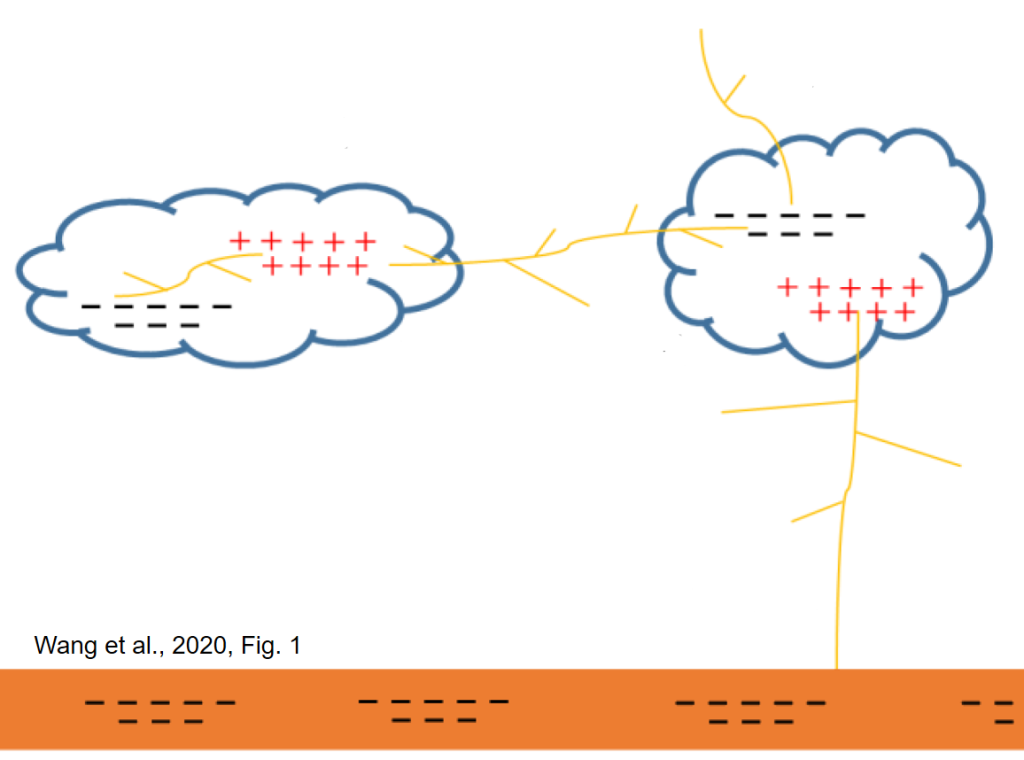
Types of lightning discharges: intra cloud, inter cloud cloud-to-ground, and cloud-to-air.
In lightning discharges, the electric charges carry high energy and can heat the discharge channel to such a degree that the air turns into hot plasma and glows bright white—this is the white flash of lightning.
A different group of atmospheric discharges begins in an electric field which is strong enough to initiate a weaker charge flow but is weak for producing a fully developed lightning discharge. In this case, ionization and excitation of the air occur in the discharge channel, but the process only reaches a so-called cold plasma state (where electrons are energetic, but the neutral air and ions remain relatively cool).
Such discharges mainly occur at the top of the cloud layer or above it at altitudes of several tens of kilometers. These can be referred to as transient luminous events (TLEs). The bluish corona discharge (St. Elmo’s fire) forming near the ground on pointed or sharp objects under strongly charged thunderclouds is essentially the same type of phenomenon.
The light produced in this process is less intense than lightning (though still clearly visible), and its color typically varies depending on the altitude (i.e., atmospheric pressure) and the type and energy of excited particles. At relatively low altitudes (up to 30–40 km), bluish-violet colors appear; higher up (up to 80–90 km), red hues are typical; while at altitudes close to 90–100 km, greenish colors may occur due to the excitation of atmospheric oxygen.

The types of known Transient Luminous Events (TLEs)
The shape of TLEs varies widely depending on their formation mechanisms and the properties of their source processes. All TLEs share the characteristics of lasting only a fraction of a second and being visible only at night.
For inspiration
In Asia: video compilation showing several types of TLEs by Angel An (Facebook) (Sound on!)
In Europe: video compilation of red sprites observations by Nicolas Escurat (Facebook) (Sound on!)
In North America: The most colorful storm, TLEs & lightning by Paul Smith (Youtube) (Sound on!)
In Australia: Lightning and TLE observations by Nature by JJ (Youtube) (Sound on!)
Production mechanisms
At higher altitudes, where air pressure and density are lower, electrical discharges can occur in electric fields that would be considered too weak for a discharge to develop near the surface. If a thundercloud, typically due to an exceptionally powerful cloud-to-ground lightning stroke, suddenly accumulates a significant excess charge in one of its regions, the resulting electric field can trigger an additional atmospheric discharge at altitudes of 60–80 km above the storm. This is one of the primary production mechanisms behind one group of upper-atmospheric discharges of electrical origin.
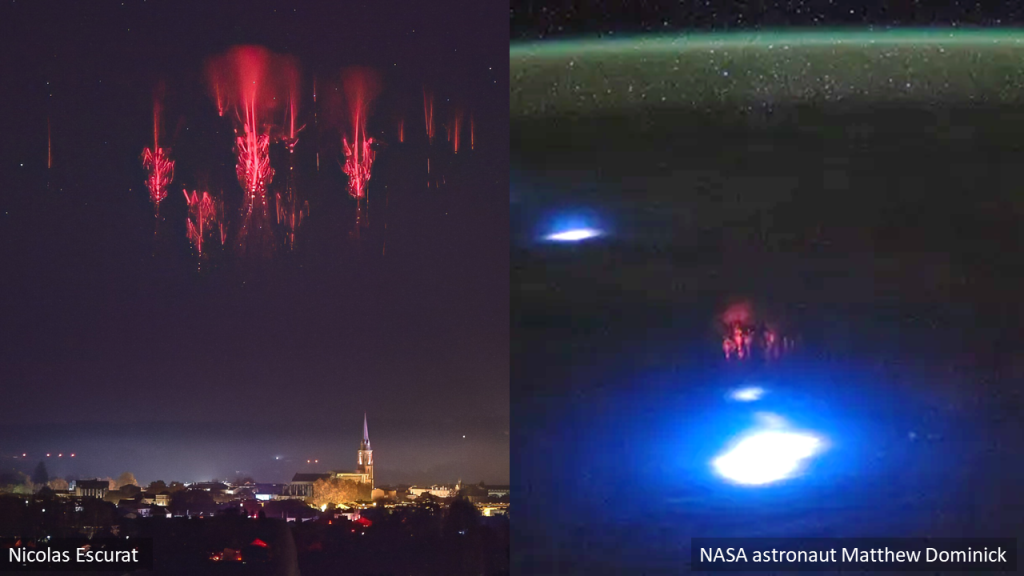
Red sprites photographed from the ground (Facebook) and from space
The red sprite is one of the luminous phenomena associated with such extreme electric discharges. It typically begins as a bright, rapidly descending point-like discharge front which leaves behind an ionized channel. In the denser, lower atmospheric layers, the discharge front often branches out, forming a network of tendril-like structures that resemble tendrils or roots. These may be bright, containing glowing patches known as “beads”, or may appear faint and barely visible. The characteristic red color of sprites becomes increasingly tinged with blue at lower altitudes, especially near or below 40 km. Note that sprites generally do not extend all the way down to the tops of the thunderclouds. The simplest form of a red sprite is columnar. If the excess charge in the cloud sustains a sufficiently strong electric field, the upper part of the sprite may brighten and additional branches can form, creating distinct shapes such as jellyfish-like, forked, wing-like, or carrot-root structures. While these basic forms are often recognizable, no two sprites are exactly the same. When the electric field is strong over a relatively large volume, multiple sprite elements can form quasi-simultaneously. Even within the same group, their shapes and sizes may vary considerably. Such sprite clusters may span an area up to 50 km across. The entire phenomenon develops dynamically and lasts only a few hundredths of a second.
As the discharge channels of some gigantic lightning flash branch out and spread across large portions of the cloud, multiple cloud-to-ground lightning events may occur in succession. Correspondingly, red sprite events can also occur in rapid succession above the clouds. This type of complex event, triggered by a sequence of gigantic lightning strikes, is referred to as dancing red sprites.
Video showing dancing red sprites (Facebook)
The sprite halo forms by the same mechanism, but requires an especially intense electric field to suddenly appear in the upper atmosphere. In such cases, discharge current begins simultaneously across an entire volume of space, and a disc- or bowl-shaped region 40–100 km wide lights up all at once at an altitude of 70–80 km. These strong fields do not persist long, so the optical lifetime of sprite halos is typically just a few milliseconds. Sprite halos may serve as the “cradles” of red sprites: if a significant electric field remains after the halo discharge, localized sprite channels may form within it.
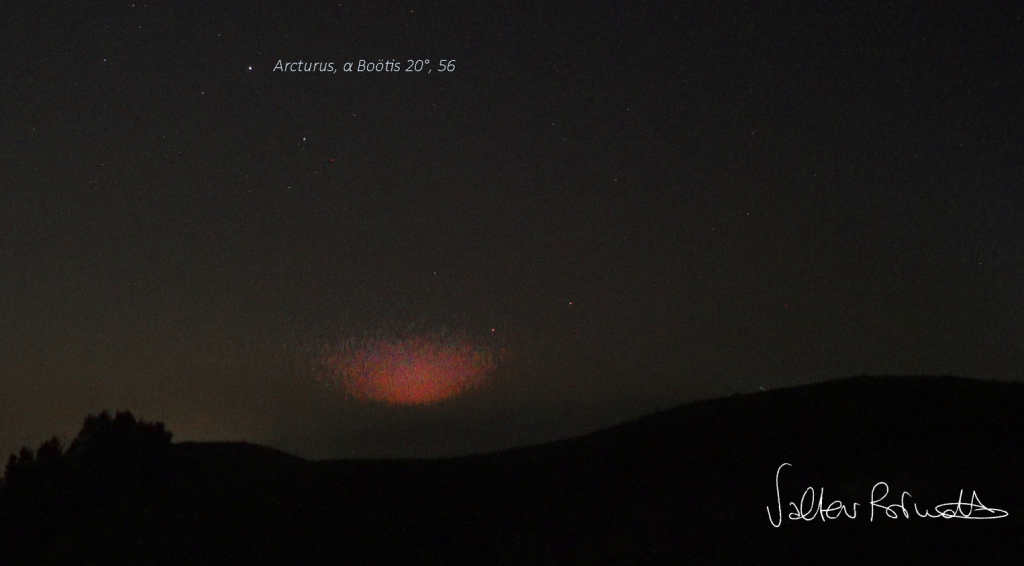
Sprite halo by Valter Binotto (Facebook)
Another class of atmospheric discharges occurs within the electric field created by (mostly positive) charge accumulations near the top of thunderclouds. For example, the repulsive force between like charges can initiate an upward current toward the free atmosphere.
If the charge reservoir in the cloud is weak or patchy, a bluish-violet flash of light resembling a corona discharge may occur. These relatively small-scale events, which appear on long-distance recordings as just a few bright pixels, are referred to as pixies.
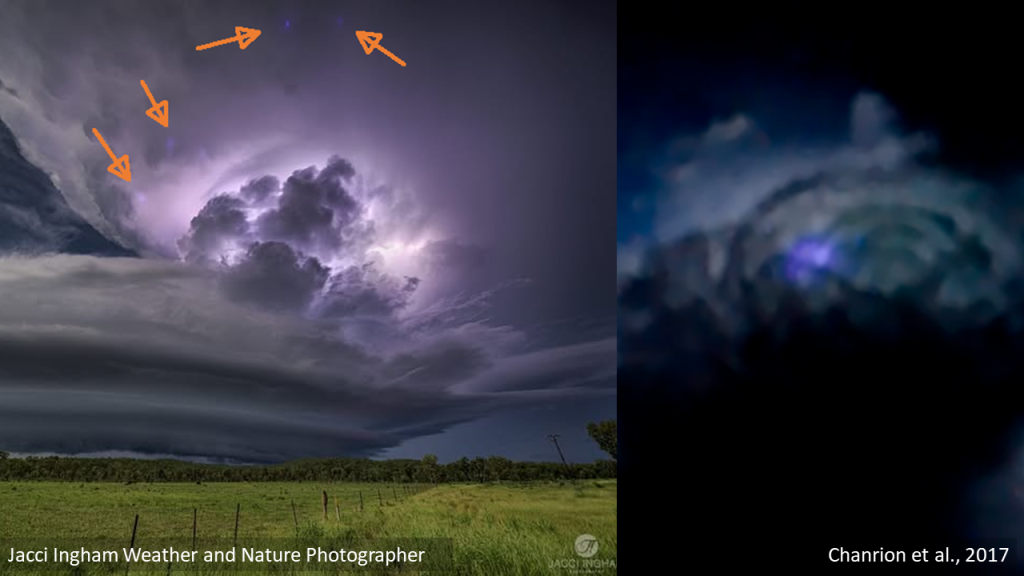
Pixies photographed from the ground (Facebook) and from space
When the parent charge region is more robust, the upward current can ionize the air farther from the origin point in the upward direction, forming a cone-shaped, widening beam of blue or bluish light that may extend to altitudes of 30–40 km. These events are called blue jets. The final altitude and brightness of a blue jet depend on the properties of the parent charge region and its ability to replenish charge. A subtype, called “blue starter”, reaches up to only about 20–25 km.
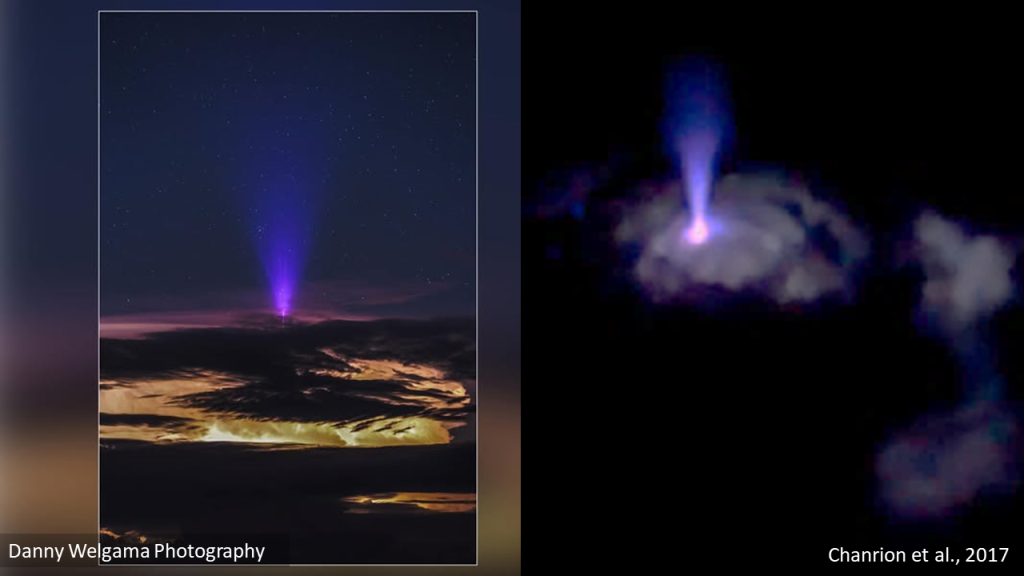
Blue jets photographed from the ground (Facebook) and from space
A video on blue jest by Paul Smith (Youtube)
The most energetic of these jets resemble upward-propagating cloud-to-air lightning discharges, but their channels tend to be straight and grow more slowly than traditional lightning. Near the cloud, the discharge creates intense ionization—likely generating hot plasma—resulting in a whitish color. The smallest events of this kind are known as gnomes. In (upward) longer events, as the electric field weakens with altitude, the process may transition into a blue jet.
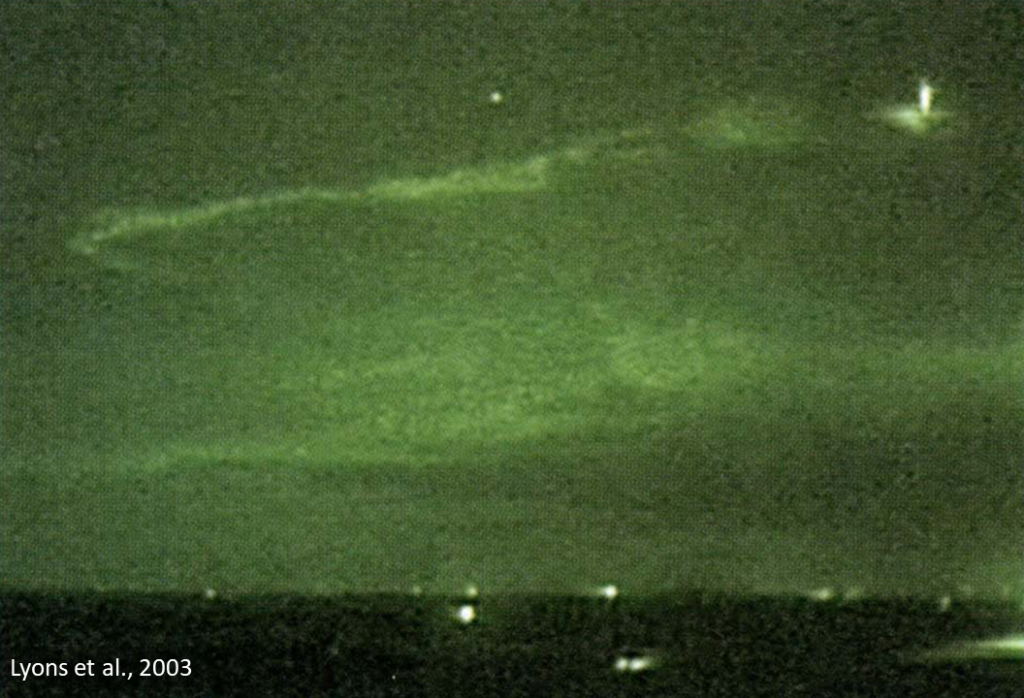
A gnome
In extreme cases, the discharge is so powerful that as it reaches higher layers of the atmosphere, where it emits red light and may extend all the way to the base of the ionosphere—a region rich in free electrons that surrounds the Earth. At night, the ionosphere typically begins at altitudes of 90–100 km. These exceptionally energetic events are called gigantic jets. The upper part of a gigantic jet may resemble large red sprites in structure, but the two phenomena differ in their lower portions. In gigantic jets, the discharge expands upward from a single origin point near the cloud top. In contrast, red sprites spread outward lower down as their descending discharge fronts repeatedly split. The two phenomena also differ in temporal evolution: red sprites are brief, lasting only a few hundredths of a second, while gigantic jets develop in multiple stages. A gigantic jet begins with a fast-rising “initial jet” that reaches toward the ionosphere. This is typically followed by a “trailing jet”—a relatively slow, upward-moving system of multiple bright discharge fronts. Altogether, gigantic jets are the longest-lasting events among upper-atmospheric luminous phenomena, although their entire duration still only approaches one second.
Some gigantic jets form via a different mechanism. A negative leader stroke from an intracloud lightning discharge may rise upward, traverse a region of diffuse positive charge at the top of the cloud, and then be guided by the positively charged base of the ionosphere and continue to propagate to higher altitudes. This is the same basic acceleration mechanism used in electronic triodes (three-electrode vacuum tubes). In nature, this gives rise to “negative-polarity gigantic jets”.
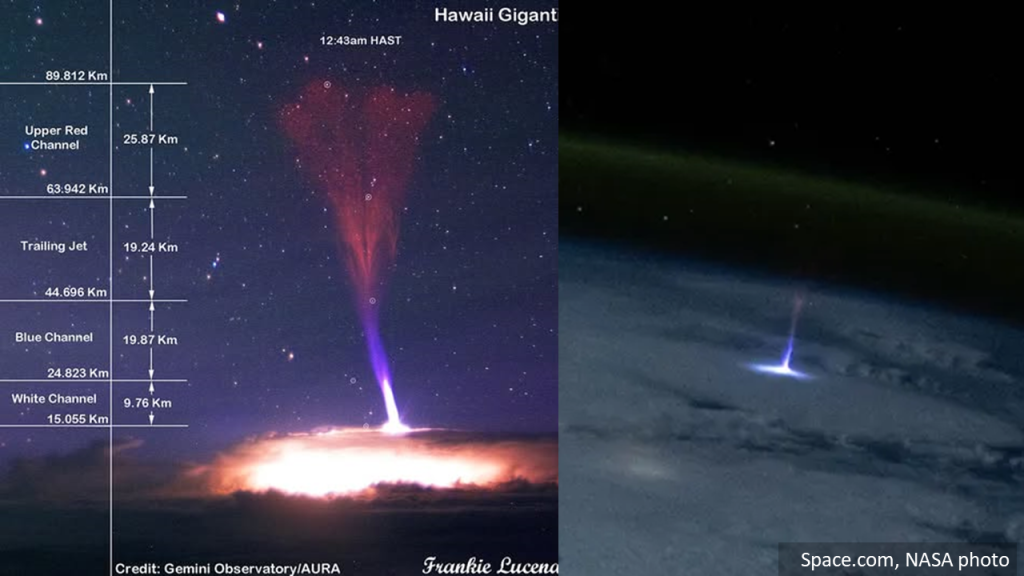
Gigantic jets photographed from the ground (Facebook) and from space (Space.com)
A video on gigantic jets by Xiaoyang Zhang (Facebook)
At times, a blue corona discharge and several short lightning-initiating branches (streamer discharges) appear simultaneously at the top of the cloud layer. These indicate a locally significant accumulation of charge which, with sufficient recharge, could potentially produce a gigantic jet. Yet, for some reason, this does not occur. Such events are known as failed gigantic jets.
In a sufficiently strong surrounding electric field, accelerated charges—primarily electrons—collide with atmospheric molecules and excite them, leading to light emission. Blue light is typically emitted by ionized N2+molecular ions, while red light comes from excited neutral nitrogen molecules. In the uppermost regions of red sprites or gigantic jets, near the lower ionosphere, atmospheric oxygen may also become excited, producing green light—similar to that seen in green auroras. This upper atmospheric excitation related to the discharge is known as a green ghost, which can sometimes remain visible for a few frames even after the red light has faded. This property means that, though rare, it may be detectable even in monochrome images.
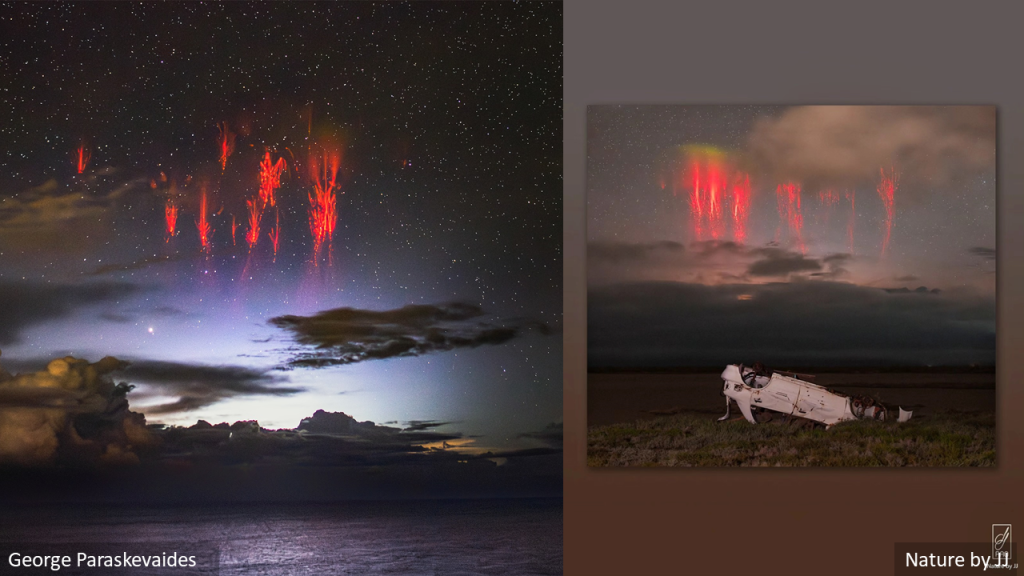
Red sprites with green ghosts (George Paraskevaides, Nature by JJ, Facebook)
A completely different process is responsible for the appearance of ELVES (Emission of Light and Very low frequency perturbations due to Electromagnetic pulse Sources) or ‘elve’s. These are triggered by exceptionally powerful lightning strokes—those with a sudden and extremely high peak current. Such lightning produces a strong electromagnetic pulse, whose electric field, having separated from a portion of the lightning channel, expands in a thin but thickening spherical shell. Within the wall of this expanding shell, the pulse’s electric field accelerates free charges present in the atmosphere. Only at altitudes around 90–100 km are conditions suitable for the surrounding free electrons to be both numerous and energetic enough (due to the pulse) to excite nitrogen molecules and cause them to emit light. Below this layer, atmospheric density is too high and the number of free electrons too low: electrons collide with molecules before they can transfer enough energy to excite them. Above this range, the atmosphere is too thin for sufficient photon emission to occur. Furthermore, the electromagnetic pulse dissipates as it moves away from its source, weakening the field.
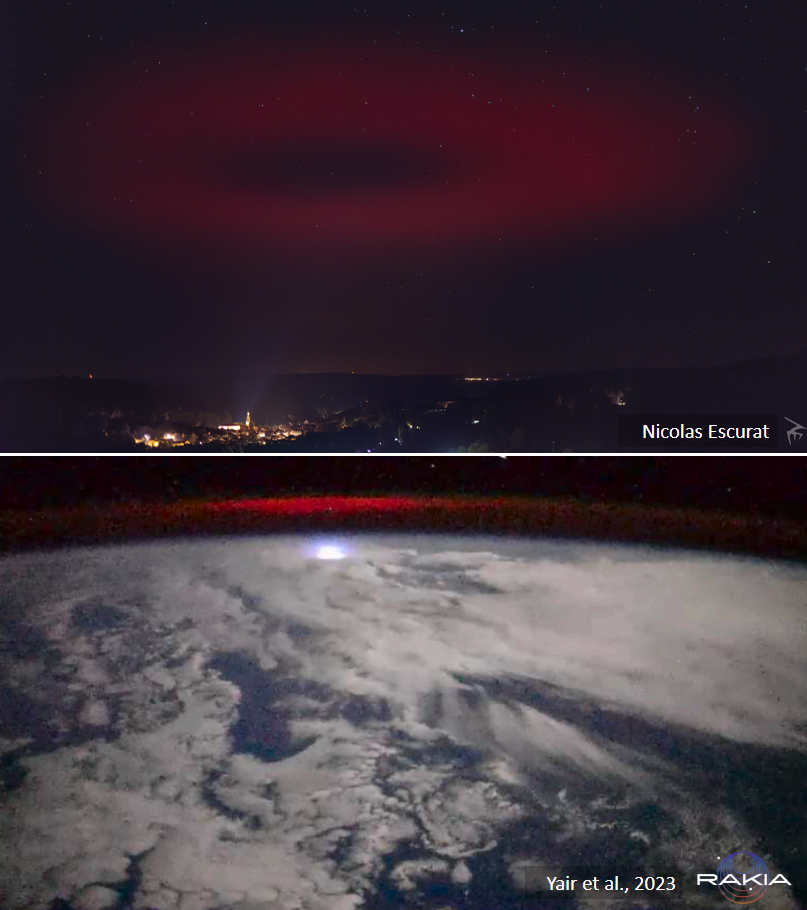
ELVES photographed from the ground (Facebook) and from space
Most of the lightning strokes that generate such strong pulses are cloud-to-ground discharges. The electromagnetic pulse originates from the side of the nearly vertical lightning channel, which means there is no electric field directly above the parent stroke. The shell of the expanding pulse reaches the appropriate altitude some distance from the lightning source, resulting in a toroidal, or donut-shaped, region of light emission in the lower ionosphere. This typical ELVES structure resembles a hollow, glowing red ring. In rare cases, horizontally extensive intracloud lightning can also produce visible ELVES, but without the characteristic central gap. ELVES are the briefest and faintest of all transient luminous events (TLEs). They are virtually imperceptible to the naked eye, lasting less than one millisecond. During this time, the red glow rapidly expands laterally, forming a structure that can span over 200 km in diameter. ELVES produced by intracloud lightning tend to be smaller in extent but still significantly larger (and clearly fainter) than sprite halos.
Some upper-atmosphere luminous phenomena only appear after the occurrence of other TLEs, most often red sprites or gigantic jets. These are referred to as secondary TLEs, as they form in an environment that has been electromagnetically altered by the prior, or primary, discharge. Their distinctive shapes and features are determined by these modified atmospheric conditions.
One such phenomenon is the troll (Transient Red Optical Luminous Lineament), also known as a crawler. It appears as a series of patchy luminous spots that sequentially occur along the deep-reaching discharge channel of a prior red sprite, giving the impression of upward motion.
A video on trolls (by Frankie Lucena, Facebook)
Another group, secondary jets, encompasses a variety of forms and formation mechanisms. Some resemble red sprites and typically follow red sprites or gigantic jets. They appear closer to the cloud tops—still above them—at altitudes similar to the lower tendrils of sprites, though they are not necessarily connected to the earlier sprite structures. These discharges have a dual structure: a few downward-pointing filaments and a single, broader, upward-moving part. The upward component may branch and, in high-speed recordings, may exhibit pulsing behavior. Because this upward channel is brighter and more prominent, these events are sometimes reminiscent of blue jets. A particular example of this are the so-called palm trees, named for their palm-frond-like appearance.
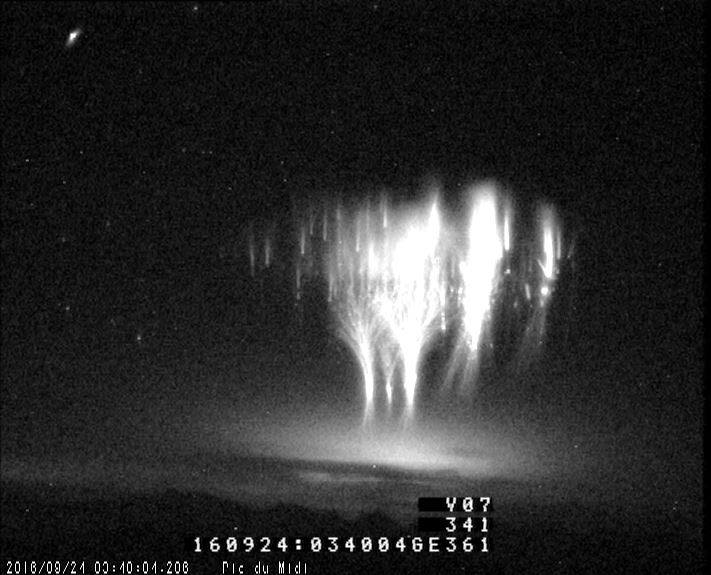
Palm trees and red sprite (image courtesy of Serge Soula and Oscar van der Velde)
In other cases, the resulting discharge takes the form of a true jet. These may include secondary blue jets, generally smaller than primary blue jets, or even secondary gigantic jets, which can be highly deformed. In such cases, the upward-moving, positively charged jet is repelled by a lower-lying, positively charged residual region left behind by a previous TLE. As a result, the jet curves around this area on its way toward the lower ionosphere.
Do we know all TLEs?
We cannot be sure about this. The diversity of environmental conditions in the atmosphere may give rise to phenomena with properties different from those observed so far. In fact, the discovery of TLEs themselves is a prime example of this. It is therefore valuable to maintain an open mindset and to closely observe the processes occurring in our surroundings—including the development of thunderstorms. Through persistent attention, we can gain deeper insights, and this is also the key to discovering new phenomena or detecting subtle changes. Noticing deviations from the norm in a timely manner may even provide humanity with strategic advantages in certain situations—for instance, in monitoring climate change or identifying potentially hazardous near-Earth asteroids.
It looks like a TLE but it isn’t one
There are many natural phenomena that may resemble certain TLEs in photographs but are not, in fact, part of this category. For various reasons, visual features may appear in an image that could be mistaken for a TLE, even though they are unrelated. Below are examples of such cases.
Light pillars seen in monochrome photographs can closely resemble column-shaped red sprites. Clues for distinguishing them include their color (real red sprites appear red or purplish), their optical duration (light pillars may persist for several minutes), and the time of capture (sprites are only visible at night).
Similarly, column-shaped auroral structures can be mistaken for sprite columns, though they can be distinguished based on their specific auroral hues and dynamics.
High-energy particles from space— cosmic rays—can collide with atmospheric molecules and create particle showers. These are part of the natural background radiation, to which the human body is adapted. When cosmic-ray particles strike the sensor of a digital camera, they can excite groups of pixels in various shapes and configurations. Sometimes, these shapes resemble red sprites. However, unlike sprites, these bright pixel clusters appear with sharp edges and high brightness. In video recordings, they are always visible in a single frame only.
Vertically falling meteors can also be mistaken for column-shaped sprites, especially in monochrome images. However, meteor trails typically taper off at both ends and emit more of a greenish glow (due to oxygen excitation in higher atmospheric layers). In video recordings, the meteor’s motion is usually clearly visible and spans multiple frames in the majority of cases.
Reflections and glare can also create TLE-like artifacts in images. These may result from strong lights scattering within the optical components of the camera (lens flare), or from external light sources (e.g. vehicle headlights) reflecting off various surfaces (such as windows, camera housing glass, spider webs, flying insects, etc.). These often appear as diffuse patches that may resemble sprite halos or faint TLEs seen through thin cloud cover.
 English
English Magyar
Magyar
